![[*]](http://sepwww.stanford.edu/latex2html/prev_gr.gif)
ABSTRACTIn this work I explore the use of surface multiple prediction in enhancing AVO estimation. Multiple reflections from a proposed reflection event are predicted using surface-related multiple prediction () and compared to the actual data to identify anomalous amplitude behavior. |
Surface-related multiple attenuation is derived from a surface-related multiple feedback equation
| U = (1-U) R | (1) |
Suppose we now generate a synthetic primary reflection, P0, with constant amplitude that matches the moveout of an actual event in our data. Assuming our data is relative amplitude compensated (i.e. divergence corrections and cable balancing are applied), then the AVO response of the multiple prediction -U P0 should match the AVO of the multiples in the actual data just as the AVO response of the primary P0 should match the AVO of the actual primary it models. If there are systematic deviations, we conclude that we are seeing an AVO effect.
This strategy offers some potentially nice features:
1-D
The surface multiple prediction
works on prestack data from a 2-D line.
In the special case of a horizontally-layered earth,
the process reduces
to a 2-D convolution of a representative
shot record with the proposed primary event.
This is equivalent to multiplying their ![]() -kx transforms
together, making investigation of the process exceptionally easy without
losing the generality of the full prestack prediction.
-kx transforms
together, making investigation of the process exceptionally easy without
losing the generality of the full prestack prediction.
Let us look at a synthetic example. Figure gather1 is an elastic synthetic seismogram generated for a point source over a 1-D earth model. This model was developed from well logs provided with the Mobil AVO dataset. Using the interactive Overlay program (), I picked the seafloor reflector and generated a flat, constant-amplitude event with the same zero-offset intercept. Filtering to the frequency range of the synthetic and inverse NMO application produced the template in Figure waterbottom. Convolving these together produces the surface multiple train in Figure waterbottom-multiples. With the exception of some aliased energy and finite-aperture artifacts, the predicted multiples align well with the multiples in the data. The phase differences are due to the half derivative implicit in two-dimensional hyperbolic summation being applied to data generated in three dimensions.
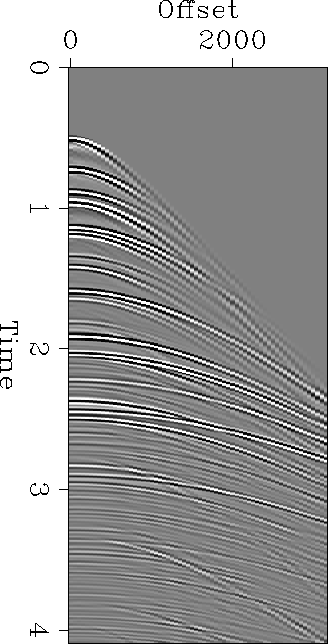 |
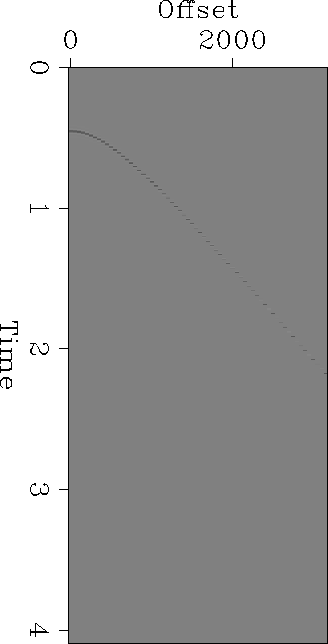 |
 |
CORRELATING OFFSETS
The ability to model relative amplitudes along multiple reflection events is not useful unless we can correlate the amplitude changes to specific offsets, or at least offset ranges, of the corresponding primary reflection. The way I've chosen to approach this problem is to emulate a ``beam'' by applying bell-shaped weights centered around specific offsets on the model primary. By inserting this smoothly-peaked function into the process, I generate a template of multiple arrivals associated with this offset. Figures waterbottom-near-offset and waterbottom-middle-offset show sample bell-weighted primaries and Figures waterbottom-multiples-near-offset and waterbottom-multiples-middle-offset show the corresponding multiple event templates they generate. You can clearly see the constant-slope peaks moving approximately radially. This amplifies the point made in the introduction: later arrivals have less angular aperture and more angular resolution. Furthermore, the aliasing artifacts from Figure waterbottom-multiples, which arise from the steep, aliased portion of the hyperbola in Figure waterbottom, are no longer present.
 |
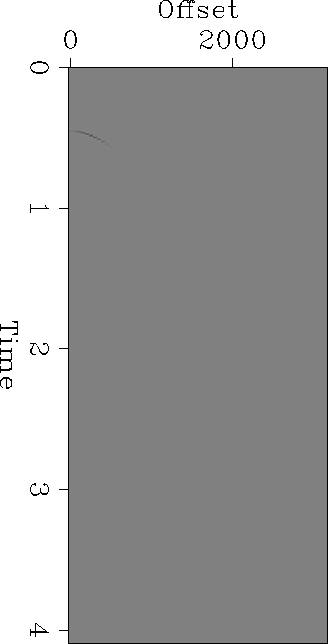 |
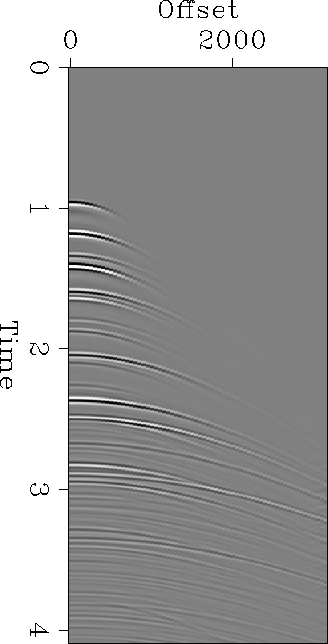 |
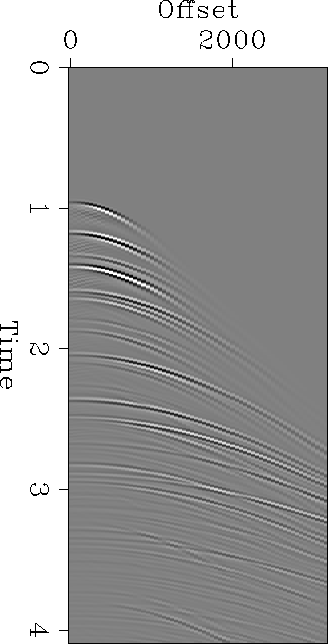 |
AVO ESTIMATION In the previous sections we have seen that multiples can be predicted and offsets can be correlated between primary and multiple arrivals. Now I turn to AVO estimation using these tools. Three strategies come to mind, which I order according to what stage the user needs to pick amplitudes:
Strategy 1 is severely hampered by the fact that multiples generally do not flatten at primary velocity, but AVO is measured along constant time slices. It will be necessary to perform velocity scans on the predicted multiples for each separate primary reflection of interest. This is essentially strategy 2 -- use the multiple template to tell us where to pick amplitudes on the multiple-contaminated data. At the time of this progress report, I have not yet worked around bugs or limitations in ProMAX that prevent me from successfully applying the needed NMO velocity profile to flatten the multiples for AVO picking.
Strategy 3 avoids direct amplitude picking and relies on being able to emulate multiples well enough so that amplitude variations with offset are not dominated by artifacts of the emulation algorithm. A fit of the offset-limited multiple panels to the input data then provides AVO estimates.
Least-squares fitting
My approach to strategy 3 is illustrated in Figures t1552-model through product-t1552-x1000. The offset axis is broken into a series of partially overlapping ranges from which a sequence of multiple models, M1 to Mn, are generated. A least-squares problem is then set up
| (2) |
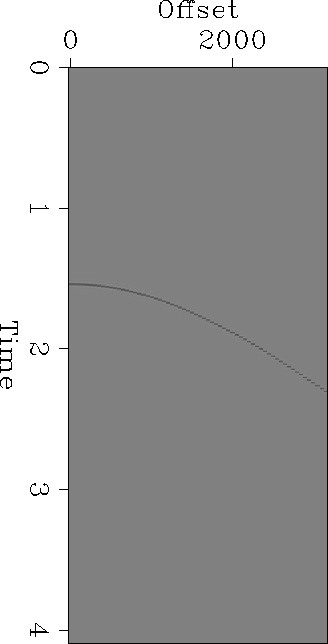 |
 |
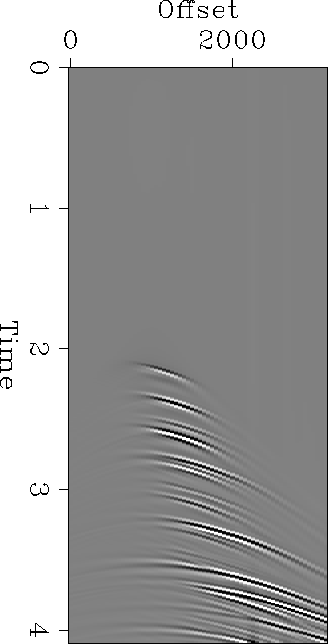 |
In more detail:
Applying this procedure to the data over the offset range 0-1800 meters, produces the AVO estimation of Figure avocoeffs. Picking the largest amplitude sample at the corresponding offsets on the primary event yields Figure primary.AVO. While we can see that both graphs have the same general trend, peaking around offset 600-800 m., the multiple estimates jump around a good deal more.
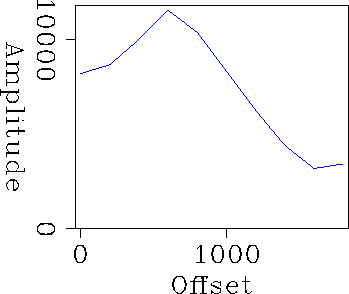 |
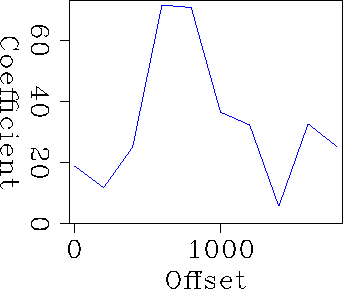 |
Blinking between the multiple template and the input data shows the probable cause of the instability -- a progressive timing shift between the early and late multiples. This reflects the sensitivity of multiples to small timing differences. In this case my zero-offset intercept time looks to be about 4 ms. too large for the model primary. Future work to appear at this year's SEG AVO workshop will address this (cf. item 8 above.)
[SEP,SEGCON,MISC]
![[*]](http://sepwww.stanford.edu/latex2html/prev_gr.gif)